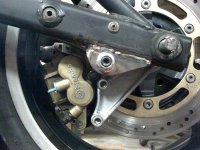For those who own V11 Sport variants... tired of having your rear brake rendered useless after a few turns in the twisties?
I'm looking to see if there is any interest in a rear brake kit that would upgrade the system including the rear master cylinder, caliper (to a 4-piston variety) and either a modified stock bracket and stay pin or one CNC'ed from scratch?
This will also finally resolve the premature bearing failure as well.
The kit would likely be ~$600 USD.
Mock-up (using used parts) on my LM track bike;
I'm looking to see if there is any interest in a rear brake kit that would upgrade the system including the rear master cylinder, caliper (to a 4-piston variety) and either a modified stock bracket and stay pin or one CNC'ed from scratch?
This will also finally resolve the premature bearing failure as well.
The kit would likely be ~$600 USD.
Mock-up (using used parts) on my LM track bike;


